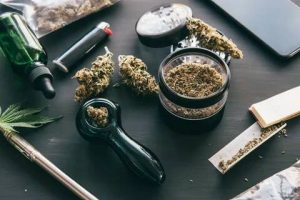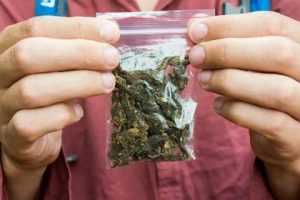
There are several methods of consuming weed, each with its own advantages and effects. Here are some common methods of consuming cannabis:
Smoking:
Smoking is a common and traditional method of using cannabis. Here’s more information about smoking as a way to consume cannabis:
- Combustion: Smoking involves igniting cannabis flowers and inhaling the resulting smoke. The heat from the flame combusts the plant material, releasing cannabinoids, terpenes, and other compounds. The smoke is then inhaled into the lungs, where the active components are absorbed into the bloodstream.
- Methods: There are different methods of smoking cannabis, including:
a. Joint: A joint is a hand-rolled cigarette using rolling papers. It consists of ground cannabis flower and can be smoked individually or shared among a group.
b. Pipe: A pipe is a handheld device that typically has a bowl to hold the cannabis flower and a mouthpiece to inhale the smoke. Pipes come in various materials, such as glass, metal, or wood, and are available in different sizes and styles.
c. Bong/Water Pipe: A bong, also known as a water pipe, includes a water chamber that cools and filters the smoke. The cannabis flower is placed in a bowl, and when the user inhales through the mouthpiece, the smoke is drawn through the water, providing a smoother hit.
d. Blunt: A blunt is a cannabis cigarette made by replacing the rolling paper with a hollowed-out cigar wrap or tobacco leaf. Blunts are typically larger than joints and can contain more cannabis.
- Rapid Onset: Smoking cannabis offers a rapid onset of effects. The cannabinoids are rapidly absorbed into the bloodstream through the lungs, leading to quick psychoactive and physiological effects. Users typically experience the effects within minutes, making it a popular choice for those seeking immediate relief or recreational enjoyment.
- Controllable Dosage: Smoking allows users to have greater control over their dosage. They can control the amount of cannabis used and take smaller or larger hits based on their preferences. However, it’s important to note that the potency of cannabis strains can vary, so it’s advisable to start with a low dose if you’re not familiar with a particular strain.
While smoking cannabis can be an enjoyable method for many people, it’s important to be aware of potential health risks associated with inhaling smoke. The combustion process creates harmful byproducts that can irritate the respiratory system and have negative long-term effects. Alternatives such as vaporizing or consuming edibles may be worth considering for those who want to avoid the potential risks of smoking.
Vaporizing:
Vaporizing, also known as vaping, is a popular method of consuming cannabis that involves heating the plant material or concentrates to a temperature that produces vapor without combustion. Here’s more information about vaporizing as a way to use cannabis:
- Vaporizer Devices: Vaporizers come in various forms, including portable handheld devices and larger tabletop units. They typically consist of a heating element, a chamber or cartridge to hold the cannabis material or concentrate, and a mouthpiece for inhaling the vapor.
- Temperature Control: Vaporizers allow users to control the temperature at which the cannabis is heated. Different cannabinoids and terpenes have varying vaporization points, and by adjusting the temperature, users can customize their experience to emphasize specific compounds or achieve desired effects. Lower temperatures tend to produce more flavorful vapor, while higher temperatures can result in more potent effects.
- Vaporization Process: When cannabis is heated in a vaporizer, the cannabinoids and terpenes are converted into vapor without combustion. This process preserves the active compounds while minimizing the production of harmful byproducts associated with smoking. The vapor can be inhaled and absorbed into the bloodstream through the lungs.
- Benefits of Vaporizing: Vaporizing is often considered a healthier alternative to smoking because it eliminates the combustion process, reducing exposure to potentially harmful substances. It provides a smoother and less harsh inhalation experience compared to smoking. Additionally, vaporizing can be more efficient in terms of cannabis utilization, as it allows for the extraction of a greater proportion of cannabinoids and terpenes from the plant material.
- Versatility: Vaporizers can be used with various forms of cannabis, including dried flower, concentrates, or oils. This versatility allows users to choose the type of cannabis product that suits their preferences and availability. Some vaporizers are specifically designed for use with concentrates like wax or shatter, while others accommodate both flower and concentrates.
It’s important to note that the effects of vaporizing cannabis can vary depending on factors such as the strain, dosage, and individual tolerance. It’s advisable to start with a low temperature and gradually increase it to find the optimal vaporization range for your preferences and desired effects.

Edibles:
Edibles are a popular and enjoyable way to consume cannabis. They refer to food weed delivery Brampton and beverages that have been infused with cannabis or cannabis extracts. Here’s more information about edibles as a way to use cannabis:
- Diverse Range of Products: Edibles come in various forms, including baked goods (e.g., brownies, cookies), candies (e.g., gummies, chocolates), beverages (e.g., teas, sodas), capsules, and more. This wide range of options allows users to choose the type of edible that suits their preferences and desired effects.
- Longer Lasting Effects: When you consume cannabis through edibles, the cannabinoids are processed by the digestive system and metabolized by the liver before entering the bloodstream. This process takes longer than inhalation methods, resulting in a slower onset of effects (typically 30 minutes to 2 hours). However, the effects of edibles tend to last longer, often lasting several hours.
- Precise Dosing: Edibles are typically labeled with their cannabinoid content, allowing for more precise dosing. This makes it easier to control your intake and adjust the dosage based on your tolerance and desired effects. It’s important to start with a low dose and wait for the effects to fully manifest before considering taking more.
- Potency Variability: The potency of edibles can vary significantly, depending on the type of edible, the strain used, and the manufacturing process. It’s important to read the labels and understand the potency of the edible you are consuming. Different individuals may have different sensitivities to edibles, so it’s crucial to be mindful of your own tolerance.
- Metabolism Factors: The effects of edibles can be influenced by individual factors such as metabolism, body weight, and tolerance. It’s advisable to consume edibles on an empty stomach for faster absorption, but this can also intensify the effects. Understanding your own body’s response to edibles is important to ensure a positive and comfortable experience.
Tinctures
Tinctures are liquid extracts made by soaking cannabis flowers or concentrates in alcohol or oil. They offer a convenient and discreet method of using cannabis. Here’s more information about tinctures as a way to use cannabis:
- Administration: Tinctures are typically consumed sublingually, which means you place a few drops under your tongue and hold them there for a short period before swallowing. This allows for faster absorption of cannabinoids into the bloodstream through the mucous membranes under the tongue.
- Precise Dosing: Tinctures provide precise dosing control. They are usually sold with a dropper or measured dispenser, allowing you to easily adjust your dosage based on your tolerance, desired effects, and experience level. It’s recommended to start with a low dose and gradually increase if needed.
- Quick Onset: Compared to edibles, tinctures have a relatively fast onset of effects. You can typically expect to feel the effects within 15-30 minutes after administration, although this can vary depending on the individual and the specific tincture formulation.
- Discreet and Odorless: Tinctures are discreet and do not have the strong smell often associated with smoking or vaporizing cannabis. They are convenient for those who prefer a more inconspicuous method of consumption, especially in situations where the smell or act of smoking is not desirable.
- Versatility: Tinctures can be made with different strains of cannabis, allowing for a wide range of cannabinoid profiles and effects. They can also be formulated with specific ratios of THC (tetrahydrocannabinol) and CBD (cannabidiol) or other cannabinoids, catering to various preferences and medicinal needs.
Topicals:
Topicals are cannabis-infused products that are designed to be applied externally to the skin. They are primarily used for localized relief and do not produce psychoactive effects when applied as directed. Here’s more information about topicals as a way to use cannabis:
- Application: Topicals come in various forms, including lotions, creams, balms, salves, oils, and patches. They are applied directly to the skin on the affected area, such as muscles, joints, or areas experiencing pain, inflammation, or skin conditions.
- Localized Relief: Topicals are primarily used for localized relief. The cannabinoids, such as THC (tetrahydrocannabinol) and CBD (cannabidiol), along with other beneficial compounds from the cannabis plant, interact with the receptors in the skin, muscles, and tissues to provide targeted relief. They may help alleviate pain, reduce inflammation, soothe muscle soreness, and promote relaxation.
- Non-Psychoactive: When applied topically, cannabis-infused products do not produce psychoactive effects. The cannabinoids generally do not enter the bloodstream in significant amounts, so they do not cause the typical high associated with other consumption methods like smoking or ingesting edibles.
- Transdermal Patches: Transdermal patches can also be considered topicals. They are adhesive patches infused with cannabinoids that are designed to deliver the compounds through the skin and into the bloodstream. Transdermal patches provide systemic effects and can be used for both localized and overall relief.
- Application Techniques: When using topicals, it’s important to clean and dry the area before applying the product. Gently massage the topical onto the skin until it is fully absorbed. Follow the instructions provided by the manufacturer regarding the recommended amount and frequency of application.
Dabbing:
Dabbing is a method of consuming cannabis concentrates through a process that involves heating the concentrate on a hot surface and inhaling the resulting vapor. It is known for its high potency and immediate effects. Here’s more information about dabbing as a way to use cannabis:
- Concentrates: Dabbing requires cannabis concentrates, which are highly potent extracts of cannabinoids, such as THC (tetrahydrocannabinol) and CBD (cannabidiol), from the cannabis plant. Common types of concentrates used for dabbing include shatter, wax, budder, and oil.
- Dab Rig: To dab, you need a specialized device called a dab rig or oil rig. A dab rig typically consists of a water pipe or bong with a nail or banger attachment made of glass, quartz, or titanium. The nail or banger is heated with a torch until it reaches the desired temperature for vaporization.
- Heating the Nail: Once the nail or banger is heated, the cannabis concentrate is applied to the hot surface using a dab tool. As the concentrate comes into contact with the hot nail, it vaporizes almost instantly, creating a dense vapor that can be inhaled.
- Inhalation and Effects: After the concentrate is vaporized, the user inhales the vapor through the mouthpiece of the dab rig. The vapor is then absorbed into the lungs, and the cannabinoids are rapidly delivered into the bloodstream, resulting in immediate and potent effects. Dabbing can produce a strong high due to the high concentration of cannabinoids in the concentrates.